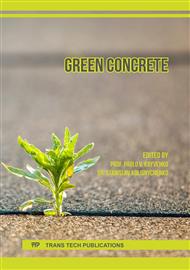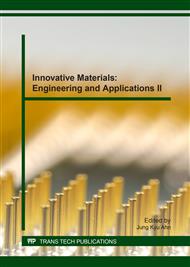[1]
I. M. Nikbin, M. H. A. Beygi, M. T. Kazemi, J. Vaseghi Amiri, S. Rabbanifar, E. Rahmani, S. Rahimi, A comprehensive investigation into the effect of water to cement ratio and powder content on mechanical properties of self-compacting concrete, Constr. Build. Mater. 57 (2014).
DOI: 10.1016/j.conbuildmat.2014.01.098
Google Scholar
[2]
S. Ismail, M. Ramli, Engineering properties of treated recycled concrete aggregate (RCA) for structural applications, Constr. Build. Mater. 44 (2013) 464–476.
DOI: 10.1016/j.conbuildmat.2013.03.014
Google Scholar
[3]
I. Ismail, N. Jamaluddin, S. Shahidan, A Review on Performance of Waste Materials in Self Compacting Concrete (SCC), J. Teknol. 5(78) (2016) 29–35.
DOI: 10.11113/jt.v78.8233
Google Scholar
[4]
M. A. Rahim, Z. Ghazaly, R. Nurazira, R. Mamat, M. A. Azizan, N. F. Isa, S. Shahidan, Experimental Study of Slurry Infiltrated Fiber Reinforced Concrete, Mater. Sci. Forum, 857 (2016) 363–366.
DOI: 10.4028/www.scientific.net/msf.857.363
Google Scholar
[5]
S. Shahidan, S. Salwa, M. Zuki, M. A. Rahim, N. Ali, Amplitude Distribution of Emission Wave for Cracking Process, MATEC Web Conf., 47 (2016) 2–8.
DOI: 10.1051/matecconf/20164702013
Google Scholar
[6]
J. Martin, J. Rodriguez Montero, F. Moreno, J. L. Piqueras Sala, M. C. Rubio, Feasibility analysis of the reuse of waste filler of bituminous mixtures for the production of self-compacting concrete, Mater. Des. 46 (2013) 372–380.
DOI: 10.1016/j.matdes.2012.10.009
Google Scholar
[7]
N. Su, K. C. Hsu, H. W. Chai, A simple mix design method for self-compacting concrete, Cem. Concr. Res. 31(12) (2001) 1799–1807.
DOI: 10.1016/s0008-8846(01)00566-x
Google Scholar
[8]
S. Shahidan, I. Isham, N. Jamaluddin, A Review on Waste Minimization by Adopting in Self Compacting Concrete MATEC Web of Conferences This review based on information gathered from available literature journal papers since 2009 till, MATEC Web Conf., 47 (2016).
DOI: 10.1051/matecconf/20164701003
Google Scholar
[9]
S. Shahidan, H. B. Koh, A. M. S. Alansi, L. Y. Loon, Strength Development and Water Permeability of Engineered Biomass Aggregate Pervious Concrete, MATEC Web Conf., 47 (2016) 2–7.
DOI: 10.1051/matecconf/20164701007
Google Scholar
[10]
H. Okamura, M. Ouchi, Self-Compacting Concrete, J. Adv. Concr. Technol. 1(1) (2003) 5–15.
Google Scholar
[11]
M. Seethapathi, S. R. R. Senthilkumar, K. Chinnaraju, Experimental Study on High Performance Self- Compacting Concrete Using Recycled Aggregate, J. Theoretic. Appl. Inform. Tech. 67(1) (2014) 84-90.
Google Scholar
[12]
K. Turk, Viscosity and hardened properties of self-compacting mortars with binary and ternary cementitious blends of fly ash and silica fume, Constr. Build. Mater. 37 (2012) 326–334.
DOI: 10.1016/j.conbuildmat.2012.07.081
Google Scholar
[13]
S. Shahidan, R. Pullin, K. M. Holford, M. B. N. N. Nor, Quantitative Evaluation of the Relationship between Tensile Crack and Shear Movement in Concrete beams, Adv. Mater. Res. 626 (2013) 355–359.
DOI: 10.4028/www.scientific.net/amr.626.355
Google Scholar
[14]
D. Chopra, R. Siddique, Kunal, Strength, permeability and microstructure of self-compacting concrete containing rice husk ash, Biosyst. Eng. 130 (2015) 72–80.
DOI: 10.1016/j.biosystemseng.2014.12.005
Google Scholar
[15]
T. E. F. of S. C. C. and C. S. Efnarc, The European Guidelines for Self-Compacting Concrete: Specification, Production and Use, Eur. Guidel. Self. Compact. Concr. 2005, p.68.
Google Scholar
[16]
S. A. Kudus, N. M. Bunnori, S. R. Basri, S. Shahidan, M. N. M. Jamil, N. M. Noor, An Overview Current Application of Artificial Neural Network in Concrete, Adv. Mater. Res. 626 (2012) 372–375.
DOI: 10.4028/www.scientific.net/amr.626.372
Google Scholar
[17]
M. Abdul Rahim, N. M. Ibrahim, Z. Idris, Z. M. Ghazaly, S. Shahidan, N. L. Rahim, L. A. Sofri, N. F. Isa, Properties of Concrete with Different Percentange of the Rice Husk Ash (RHA) as Partial Cement Replacement, Mater. Sci. Forum, 803 (2014).
DOI: 10.4028/www.scientific.net/msf.803.288
Google Scholar
[18]
N. Md Nor, N. Muhamad Bunnori, A. Ibrahim, S. Shahidan, S. N. M. Saliah, An investigation on acoustic wave velocity of reinforced concrete beam in-plane source, in Proceedings - 2011 IEEE 7th International Colloquium on Signal Processing and Its Applications, CSPA 2011, (2011).
DOI: 10.1109/cspa.2011.5759835
Google Scholar



